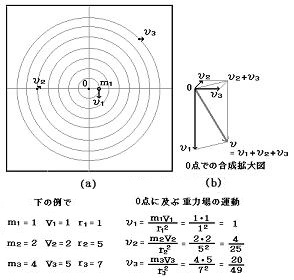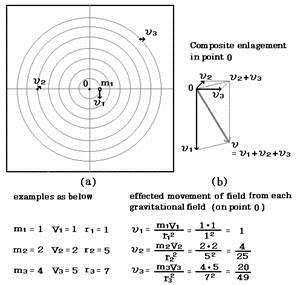
第3図
第2図にある天体m3を例にとりますと、O点から距離7r1にある質点m3のつくる重力場がO点に及ぼす重力場の強さは、ニュートンの万有引力の法則から、m1のそれに比べ1/(7r1)2になるでありましょう。質量m3がm1の4倍だとしますと、その運動速度V3がO点に及ぼしている影響はV3×4m1/(7r1)2となると考え、この値をυ3とします。
これはm1による重力場運動に対し、どれほどの比になるかをみますと、まずm1がO点に及ぼす速さは、さきのような計算で、υ1=V1×m1/r12ということになります。
つぎに、さっきのV3がm1のもつ速さV1の5倍あるとしますと、υ3は
υ3=5V1×4m1/(7r1)2
と表わせます。υ1に対する絶対値の比をとってみますと
υ3/υ1
=[5V1×4m1/(7 r1) 2]/[V1×m1/r12]
従ってυ3をυ1で表わしますと
υ3=[5×4×r12/(7r1)2]υ1
=[5×4/49]υ1
となります。第3図、下の表でυ1=1×υ1としますと、υ3は
υ3=(20/49)υ1です。
m2を例にとっても、同様の考えから、そのυ2はυ2=(4/25)υ1と得られます。
各天体からO点に及ぶ重力場の運動速度υ1、υ2、υ3をO点で合成するには、第3(b)図に示すベクトル合成によります。
これは第2図のV1と同じであるはずのものを、
